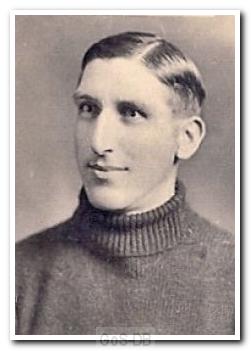
Can you help? This page is the result of the best endeavours of all concerned. If you spot a mistake or know of facts to add, or have a better photo, please get in touch using 'Contact Us' (top, right).
Back to GoS-DB Hub Find Another Player
FRED CRAIG
Full Name: Frederick Glover Craig
Born: 16 January 1893
1. Came from: Larkhall Thistle Went to: Career interrupted by WW1
1. First game: 09 November 1912 Last game: 01 May 1915
2. Came from: Career interrupted by WW1 Went to: Barrow
2. First game: 30 August 1919 Last game: 15 March 1930
Appearances: 472 (472/0) Goals: 5
Craig was born in Larkhall, Lanarkshire in 1893. He began playing football as a juvenile with Glenview and from there stepped up to Larkhall United in 1909. A year later he was with Ross Rovers in Ferniegair and gained a county cap against Ayrshire Juniors before joining Larkhall Thistle, Scotland's oldest junior club, in 1911. (A junior club in Scotland is broadly the equivalent of a non-league club in England, and does not imply a young team.) It was whilst playing for Thistle that he was spotted by Bob Jack, who signed him for Argyle in July 1912.
After two years as understudy to 'Tich' Horne, Craig took over as first-choice 'keeper midway through the 1914-15 campaign. However, the First World War, already a year old, finally called a halt to football at the end of that season and Craig found himself driving heavy trucks between London and the Channel ports. He played briefly for Brentford before returning to Scotland, where he played for Royal Albert, Vale of Leven, St. Johnstone, Ayr United, Hamilton Academical and Motherwell during the war. He made his Hamilton debut in March 1916, the first of 42 games and nine clean sheets for the club.
Craig was back in Plymouth for the resumption of the Football League in August 1919 and became a fixture in the first team for the next ten years. He accumulated a remarkable run of 109 consecutive league and cup games between September 1919 and December 1921, for which he was presented a gold medal by the club's directors at a benefit game for him in May 1922. Perhaps that was the inspiration for an even more impressive run: after missing the first game of the following season he totted up an astonishing 181 consecutive appearances between August 1922 and September 1926, the third best sequence in Argyle's history. And in the 1921-22 campaign, Craig let in only 26 league and cup goals, which remains the club's all-time low for a season.
He was also selected to keep goal for the Anglo-Scots side against the Home Scots in January 1917 (whilst with Hamilton) and again in March 1923. The annual fixture was effectively a trial match for the Scotland team. Playing with him in the 1923 game was his Argyle team-mate, Paddy Corcoran, at outside-right.
A tall goalkeeper, Craig was excellent when dealing with crosses but also had great agility. The Argyle handbook stated that he "has every attribute of a first-class goalkeeper, is a valuable asset to the club". In the last few years of his time at Home Park he often took penalties, especially in important situations, and scored five times from the spot and is still to this day the only goalkeeper to have scored for the club.
His 18-year relationship with Argyle was rewarded in 1929-30, his final season with the club; he captained the side for much of the campaign and won a Third Division (South) Champions' medal, after which he ended his career with a short spell with Barrow. He was enticed to Cumbria by his old friend Tom Miller, who was Barrow's manager at that time, despite being much sought after, particularly in Scotland. He later coached his works' team in Corby, a town in Northamptonshire that is often dubbed 'Little Scotland' because of the influx of Scots who were drawn to the steelworks in the 1930s. Interestingly, in October 1940 the Motherwell Times reported that a team of Scottish 'old stagers' lost 5-4 to Corby Works in a match that raised £40 for the Corby Spitfire fund. In goal for the Scottish ex-professionals was a 47-year-old former Motherwell player, Fred Craig.
Fred eventually returning to his hometown, Larkhall in Scotland, where he lived for the rest of his days.
Footnote: written with help from www.acciesmemorybank.co.uk.
YOUR CONTRIBUTION
If you can add to this profile, perhaps with special memories, a favourite story or the results of your original research, please contribute here.
APPEARANCE DETAILS [reselect competitions]
The details below reflect appearances in all first-team competitions.
I'm very grateful to many who have helped write GoS-DB's player pen-pictures, and to Dave Rowntree, the PAFC Media Team and Colin Parsons for their help with photos. Thanks also to staff at the National Football Museum, the Scottish Football Museum and ScotlandsPeople for their valuable assistance.
The following publications have been particularly valuable in the research of pen-pictures: Plymouth Argyle, A Complete Record 1903-1989 (Brian Knight, ISBN 0-907969-40-2); Plymouth Argyle, 101 Golden Greats (Andy Riddle, ISBN 1-874287-47-3); Football League Players' Records 1888-1939 (Michael Joyce, ISBN 1-899468-67-6); Football League Players' Records 1946-1988 (Barry Hugman, ISBN 1-85443-020-3) and Plymouth Argyle Football Club Handbooks.
Greens on Screen is run as a service to fellow supporters, in all good faith, without commercial or private gain. We have no wish to abuse copyright regulations and apologise unreservedly if this occurs. If you own any of the material used on this site, and object to its inclusion, please get in touch using the 'Contact Us' button at the top of each page.

